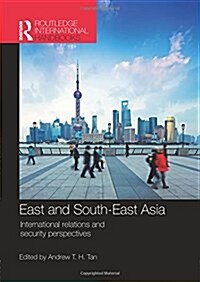
East and South-East Asia: international relations and security perspectives
- 발행사항
- New York : Routledge, Taylor & Francis Group, 2013
- 형태사항
- xxi, 311 p. : 26cm
- ISBN
- 9781857438253
- 청구기호
- 349.1 T161e
- 서지주기
- Includes bibliographical references and index
소장정보
| 위치 | 등록번호 | 청구기호 / 출력 | 상태 | 반납예정일 |
|---|---|---|---|---|
이용 가능 (1) | ||||
| 1자료실 | 00015821 | 대출가능 | - | |
- 등록번호
- 00015821
- 상태/반납예정일
- 대출가능
- -
- 위치/청구기호(출력)
- 1자료실
책 소개
The economic growth of East and South-East Asia in the context of the global financial crisis has strengthened the view that this region is emerging in the 21st century as the most economically vibrant region in the world. With some of the largest economies, and generally high economic growth rates compared to the rest of the world, it is unsurprising that East and South-East Asia has become the subject of global interest.
East Asia’s rise inevitably focuses attention on the issue of China’s emergence as a regional and global power. Such a prospect challenges the current status quo, in which the region is dominated by the USA and its regional allies, and issues in Sino-US strategic relations have raised global awareness of the need to understand this pivotal region better. In addition, the Taiwan issue continues to evoke nationalist sentiments in China, and North Korea continues to threaten regional stability.
Non-traditional (or alternative) security issues are also of major importance in the region, including natural disasters and epidemics, as well as challenges relating to human rights and governance, transnational crime, demographic issues, economics and trade and regionalism.
This Handbook aims to offer an insight into these issues. The volume is divided into two main sections. The first, International Relations and Security Perspectives, will focus on the international relations of the region, paying special attention to the key state players. The chapter contributions will examine the security perspectives, and foreign and defence policies of these states, as well as key bilateral relationships. The second section will examine key Regional Non-traditional Security Issues, including globalization, transnational health challenges, population growth and the environment.
This Handbook aims to offer an insight into the issues surrounding the economic growth of East and South-East Asia, the relations between the countries of the region and between these countries and other economic powers of the world, and the security and non-traditional security issues facing the regions. The volume is divided into two main sections. The first, International Relations and Security Perspectives, will focus on the international relations of the region, paying special attention to the key state players. The chapter contributions will examine the security perspectives, and foreign and defence policies of these states, as well as key bilateral relationships. The second section will examine key Regional Non-traditional Security Issues, including globalization, transnational health challenges, population growth and the environment.
목차
Introduction 1. The Rise of East and South-East Asia: Challenges and Security Perspectives Andrew T. H. TanInternational Relations and Security Perspectives 2. China’s International Relations and Security Perspectives Jing Huang 3. The Limitations of Deterrence: China’s Response to Military Balancing in the Western Pacific Jonathan Holslag 4. The "China Threat" Conundrum in East and South-East AsiaAndrew T. H. Tan 5. The False Promise of Economic Interdependence: Chinese Foreign Policy in North-East Asia Nicholas Khoo 6. China’s Approach to North Korea: Seeking Stability and Influence Amid Changing Circumstances and Conflicting Imperatives Robert G. Sutter 7. China-Japan Relations: Competition Amidst Interdependence Paul J. Smith 8. China and Taiwan Relations: Challenges and Prospects Sheryn Lee 9. China-South-East Asian Relations Since the Cold War Ja Ian Chong 10. Japan - (More or Less) Normal Military Power Axel Berkofsky 11. The Future of the US-Japan Alliance Christopher W. Hughes 12. North Korea’s Security Perspectives Hazel Smith 13. North Korea's Impact on North-East Asian Security Nolan Theisen 14. Inter-Korean Relations and the Challenge of North-East Asian Regional Security John Swenson-Wright 15. South-East Asia’s International Relations and Security Perspectives Jurgen Haacke 16. The USA’s Relations with East and South-East Asia Mark Beeson Regional Non-Traditional Security Issues 17. Globalization and East and South-East Asia Alistair D. B. Cook 18. Environmental Challenges in East and South-East Asia J. Jackson Ewing 19. Environmental Challenges in China Graeme Lang 20. Future Pandemics: Transnational Health Challenges in East and South-East Asia Allen Yu-Hung Lai, Adam Kamradt-Scott and Richard Coker 21. Transnational Organized Crime in East and South-East Asia Roderic Broadhurst and Vy Kim Le 22. Terrorism in South-East Asia After 9-11 Andrew T. H. Tan 23. Maritime Security in East and South-East Asia Justin V. Hastings 24. Demographic Ageing in China: Economic Problem or Social Opportunity? Phil Mullan and Bill Durodie 25. Japan’s Demographic Crisis: Security Implications and Obstacles to Resolving an Issue Symptomatic of National Decline Brad Williams 26. The Future of Regionalism in East and South-East Asia Christopher B. Roberts

